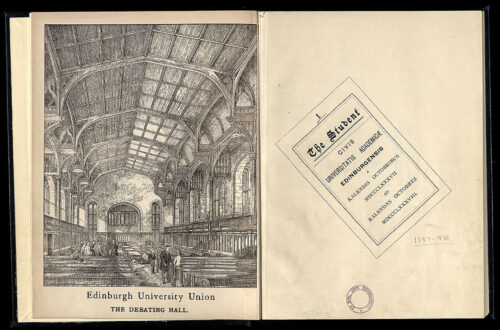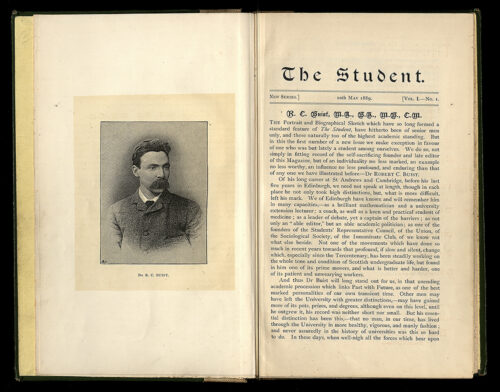
In February 2022, PhD students Vesna Curlic and Ash Charlton began their digitisation internships in partnership with the University of Edinburgh’s Library and University Collections and the Centre for Data, Culture, and Society. Together, they reflect on the joys and challenges of digitisation.
We were tasked with an internship project that has two main parts – half our time is spent in the Cultural Heritage Digitisation Service’s Digital Imaging Unit (DIU) in the University’s Main Library scanning early volumes of The Student, University of Edinburgh’s student newspaper. The other half of the time, we work to develop a training pathway for the Centre for Data, Culture and Society which will direct people towards resources for undertaking their own digitising projects. This post is part one of two, reflecting on our experiences digitising The Student.
A typical day in the DIU starts by getting everything set up – making sure the scanner is running well and is clean, checking that all the software is working, and getting the archival material out of the storage room. For our internship, we use the BookEye 4 Scanner, which has a V-shaped glass plate for use with bound books. Though there are dozens of diverse ways of capturing material in the DIU, The Student volumes contain multiple issues bound together by year, so need to be handled and supported carefully with the V-shaped scanner so the binding isn’t put under unnecessary pressure. Digitising days are mostly spent in a darkened room, quietly lifting glass, flipping pages, scanning, and fiddling around with the scanned images, interspersed with cataloguing and collaborating with colleagues. It’s a calm, meditative kind of work – a pleasant change from the unpredictable pace of PhD life.
Vesna Curlic:
Though the digitisation studio is calm, the work isn’t without its occasional hiccups. In fact, much of digitisation work has turned out to be about problem solving. The digital versions of The Student volumes are large and rendered in high resolution to meet researchers’ needs. This meant that the computer occasionally has trouble processing these volumes, and that creative solutions and teamwork were an essential part of the internship. Luckily, every member of the DIU team was always willing to lend a hand, and it quickly became clear to me that digitisation requires a collaborative, dynamic workflow.
Though I have plenty of experience in heritage settings, I am technically trained as a historian and it was occasionally a challenge to image the material in front of me as an object to be captured, rather than a document to be analysed. It was a constant battle to not get distracted by the words on the page. Still, it was nice to go against this instinctual feeling, to force myself to think in a different way. My experience in the digitisation studio also serves to put a lot into perspective for me as a researcher. There is perennial tension between archivists and researchers: archive staff doing the best they can with competing priorities, and researchers who all feel that their project is the most important priority. Working on the digitisation of The Student has put into stark clarity the work that goes into the digital resources that researchers use daily. Not only did someone interact with every single page of any digitised manuscript, but someone also took the time to catalogue all the material so it could be found, writing the item description and imagining all the possible uses a researcher might have for this object. My time in the digitisation studio has been an excellent reminder of the time, effort, and care that goes into every single page of digitised material available to us all.
Ash Charlton:
The physical materiality of an item is sometimes difficult to convey through digitisation and text is often considered the most important aspect to capture. Despite this, imaging the full object is key as it contextualises the text within the overall publication. Although it’s difficult to get a sense of the full size and scale of The Student editions, we imaged each bound edition from cover to cover which gives more a sense of the full object when viewed online. This is also useful to serve as a record of the object at the time of digitisation, reflecting any damage or marks that may be used for reference in conservation and preservation projects.
Before each issue there is a page containing an illustration on a different paper type than the rest of the volume. These are on a white, glossy paper that looks (and feels!) different to the rest of The Student editions. This is a challenge to convey in the scans; this difference can look strange as it looks like the lighting and exposure might be wrong, but the images are representing the different paper types. The same applies for some of the discoloured pages such as endpapers that do not fit with the main text block – as someone accessing it you may think it’s an issue with imaging when it’s a variation in paper type or condition. These differences are something we’ve had to be aware of when scanning and carrying out quality assurance.

Images from The Student 1889 (EUA IN20/PUB/1/1889), demonstrating the yellow end papers in comparison with the paler paper ( yellow strip on the far left), and the white, paler glossy page in comparison with the main body of text on a different paper type in The Student (left vs. right).
An important aspect of my experience is recognising how much human labour goes into the process that isn’t always apparent in the final product. It’s easy to assume digitisation is largely automated; scanning devices and computer software certainly speed up the process, but human intervention is needed at each step to create the result. From lighting adjustments, manually turning pages for capture, using the foot pedal or capture button, to exporting and preparing the images into a pdf file for quality assurance. Working on The Student was a fantastic chance to work with a range of equipment and gain a better understanding of behind-the-scenes digitisation processes from start to finish and the labour that goes into it.
The new copies of The Student can be seen here https://openbooks.is.ed.ac.uk//search/*:*/Author:%22university+of+edinburgh.+students%27+representative+council+%7C%7C%7C+University+of+Edinburgh.+Students%27+Representative+Council%22
And you can find out more about the Centre for Data Culture and Society Internships here https://blogs.ed.ac.uk/cdcs/2022/09/06/cdcs-digitisation-internship-creating-the-managing-digitised-documents-pathway/
Be First to Comment